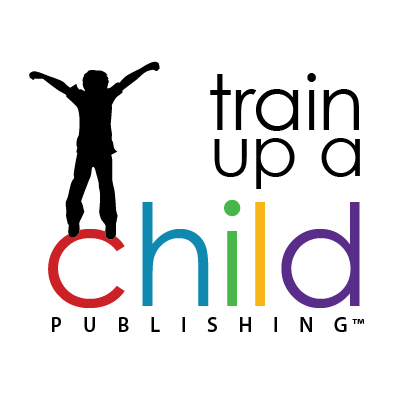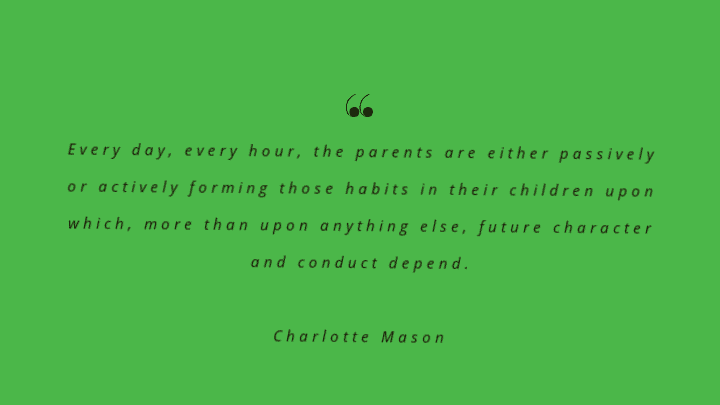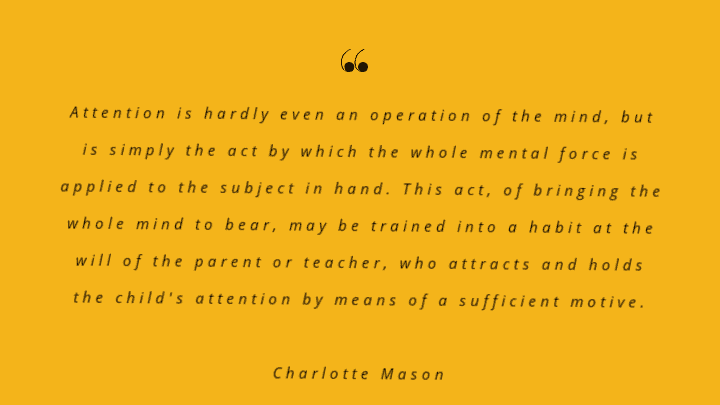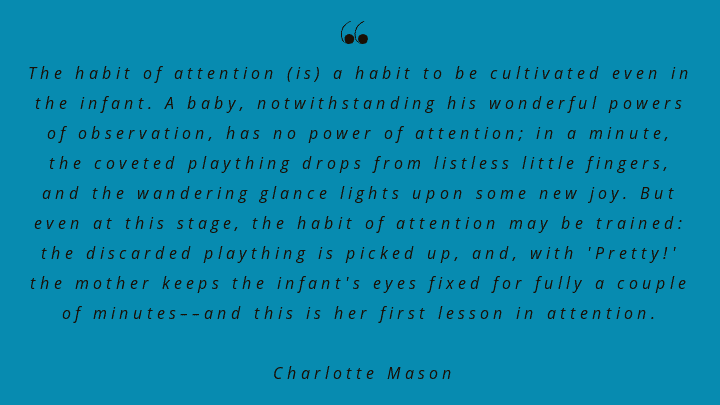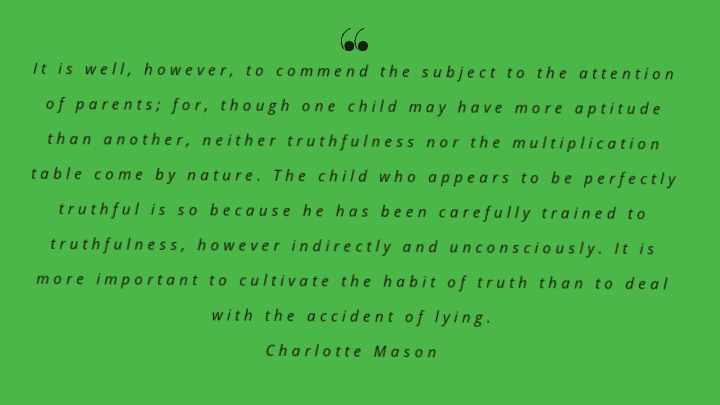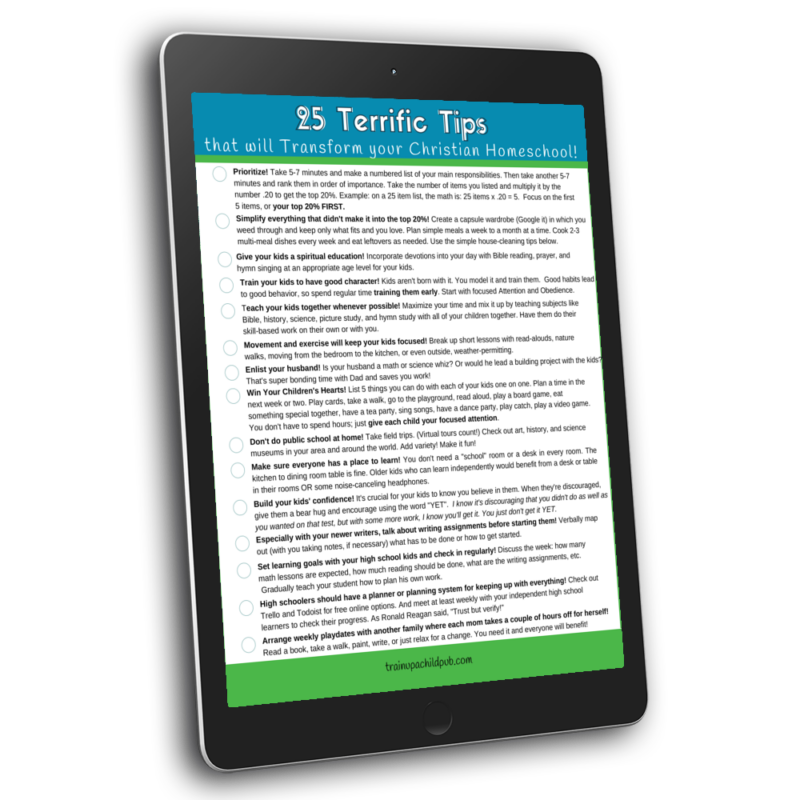The 3 crucial Charlotte Mason habits to teach your kids now

Do you feel as though your children are out of control a lot of the time? They don’t listen well? They don’t obey consistently? Do you have to count to three before they pay any attention to you at all? If so, it’s time to work on training (or retraining) your kids in good habits. If you’ve read about “Charlotte Mason habit training” and are overwhelmed with the 60+ good habits for kids she suggested —don’t worry! Just start now with these three crucial habits in this order:
- Attention
- Obedience
- Truthfulness
Especially if you are home-educating your kids and having constant battles, it’s time to take a step back and focus on child training.
If you aren’t sure you understand what I mean when I say “Charlotte Mason habits,” read this post: Basic Habit Training.
But don’t worry if “Charlotte Mason” habits aren’t on your radar screen at all. Because the three habits you’re going to learn how to teach your kids in this post are good habits for kids, no matter whether you’ve ever heard of Charlotte Mason or not.
And if you work consistently on these three habits alone, your household and your homeschooling will run so much more smoothly!
Why is it important to teach kids good habits?
Because it’s our job as Christian parents to train our kids’ character. It doesn’t happen by osmosis, unfortunately! And that’s why there are so many verses in the Bible that teach us that we are to train our kids, teach them, give them instruction, disciple them, and discipline them.
And good habits result in good character.
I love this quote by Charlotte Mason, a turn-of-the-century British educator.
This is a weighty quote, isn’t it?
So the foundation of your child’s character and conduct is made up of learning and practicing good habits. And if we aren’t purposefully teaching our kids good habits… they are probably learning some bad ones. So let’s get started.
So when I’m ready to train my kids to have good habits, what must I know first?
Just like with almost everything else, training your kids in good habits starts with you.
- Make a plan to work on each of these three habits one at a time.
- If necessary, simplify your schedule so you can be patient, relaxed, and calm while you train your kids.
- Plan on working on each habit regularly for about four to six weeks. I know it seems like a long time! But it takes a while for your child to really get a habit down. These first two crucial habits are foundational for all the rest, so you’ll have better results if you train these habits in this order.
As you train your children to have good habits, remember to only give one simple instruction at a time, especially to a very young child. Get your toddler’s attention, and then give one instruction. When you’re working on habit training, don’t try to do it at the playground with a group of shrieking children nearby.
Or when your child is hungry or tired. Or when YOU are hungry and over-tired.
And — this is important — please don’t get in the habit of repeating yourself to your children. That teaches them not to pay attention until you raise your voice or repeat yourself numerous times. And never “count to three.”
I know this is hard work, and often it’s the last thing you want to do. Especially when so many other tasks are calling your name.
Want to grab a downloadable copy of this post to read later?
When are my kids ready to begin learning good habits?
Earlier than you might think.
Your baby’s eyes are following you around while he sits nearby in his Bumbo chair, watching you clean up the kitchen. As you chat with him while you go about your chores, he sees you pick up the legos, chop vegetables for the crockpot, and feed your dog. He’s already noticing patterns of your behavior.
Even at this young age, your child is a sponge. He is starting to understand an amazing number of words and is ready for you to start teaching him the very first of the three crucial habits to teach your children.
Crucial Charlotte Mason Habit #1 is Attention
Have you ever watched a two-year-old lying spreadeagled on the sidewalk, totally captivated by a crawling snail leaving his shimmering trail behind? Then you might agree with Charlotte Mason’s belief that children naturally have an incredible capacity for focused attention. It’s already there!
You just have to help it along by encouraging your littles not just to see, but to appreciate, and to focus on what you are saying.
And babies are not too young to begin learning.
Another strategy to start teaching the habit of attention is teaching your baby sign language.
Note that we are part of the Amazon Affiliate program, and this post contains affiliate links to books and items we’ve used and loved. If you should make a qualifying purchase using our links, we will make a few cents per book, at no additional cost to you. But we appreciate your support! Many thanks!!
Teaching the habit of attention by teaching your baby sign language
Teaching your baby a few simple signs is a wonderful way to begin teaching her to pay attention to you. For example, you can teach your baby to let you know she wants “more” or “milk.” When she’s done eating, you can teach her to tell you with a simple sign that she’s “all done” and ready to get out of her high chair. It’s so gratifying and helpful for both of you to communicate with your child before she can even talk!
You can start at about 8 or 9 months of age saying and signing something at the same time. When you see your child is getting restless after lunch and considering tossing his food onto the floor, you can say, “All done,” while demonstrating the “all done” sign. It will be a few months before your child can sign back to you and the first attempts might be hard to recognize, but it will get better!
Interestingly, teaching babies sign language can improve parent-child bonding as well as language development. If you are in the baby stage and interested in teaching your baby sign language, here are two books to help you get started, with what I like about each one:
I like this one because it has just a handful of practical, everyday signs. Your littles will enjoy the simple illustrations and short length of this cute little book.
I like this one because it pictures children of all skin colors. It also includes many more signs and an easy-to-understand pictorial ASL alphabet. Incidentally, at the time of this writing, this helpful book is free if you have a subscription to Kindle Unlimited. (Which is well worth it if you and your children read a lot of books.)
Teaching the habit of attention to a preschooler
If your child is a little older, here’s how you can practice the Charlotte Mason habit of attention.
Again, to learn from you, your child needs to listen to you. He needs to learn to pay attention to what you are saying. This is critical, possibly even lifesaving. Think of a child playing who suddenly runs into the street with a car coming. At your sudden “STOP!” your child needs to hear you and stop!
So here’s how to start:
First, remember that the foundation for homeschooling is the Christ-centered mentoring and discipleship of our children. And lifegiving homeschooling is built on that foundation. The Bible tells us clearly that parents are responsible for training their children. And it’s our children’s job to obey us. So humbly explaining to our kids that God has given parents a special job (training) and children a special job (obeying) is the first place to start. You will have to repeat this.
Then train your child that when you are speaking to him, he needs to:
- Stop what he’s doing.
- Look you in the eyes.
- Listen to what you are saying.
- Repeat what you said to make sure he understands.
Praise for effort and making progress really help your child want to do well.
Other ways to help your preschool and elementary children practice the habit of attention…
Go on lots of nature walks outdoors. Help your children not just walk, but notice that tree she’s walking past. Stop and make the tree more interesting by talking about all the things there are to notice about the tree:
-
- “Look at the bark of this tree. How does it feel?” (Rough or smooth?)
- “What color is it? How is it different from those trees over there?” (light brown, dark brown, gray) (lighter, darker, more than one color, patterned, smooth, rough…)
- “What shape are the leaves? What color are they?”
- “Do you see any animals in or on this tree?” (birds, squirrels, caterpillars?)
 Teach your child to narrate. Narration is your child telling back what he has heard or seen. This is one of the very best ways to practice the habit of attention because your child will narrate after hearing or seeing something only once. Start with short Bible stories and Aesop’s Fables. If narration is new to you, here’s more information about how to teach narration.
Teach your child to narrate. Narration is your child telling back what he has heard or seen. This is one of the very best ways to practice the habit of attention because your child will narrate after hearing or seeing something only once. Start with short Bible stories and Aesop’s Fables. If narration is new to you, here’s more information about how to teach narration.
Additionally, spend frequent time talking one-on-one with each of your children. One of the most important things for language development is simply talking to your child. While you are talking, make sure to model what you want her to do: stop what you’re doing, look her in the eye, and listen to what she is saying.
Practicing the habit of attention in late elementary and older children.
- Continue with narration over reading material. Narrations at this age can be oral and written and may include longer passages of not just literature, but a science or history selection, or even over a painting or a piece of music.
- Provide spiral-bound drawing or watercolor pads for your kids, and begin nature journals. On your regular (weekly or more) time outdoors, have your children choose something that interests them. Have them draw it and write a few sentences about what they have observed and drawn. Make sure they date the page. Drawing something and writing about it practice the focused attention you want to build in your students.
- In high school, you’ll continue oral and written narrations over longer and more complicated material, as well as more detailed nature journals.
Once you have your child’s attention, you can move on to Charlotte Mason Habit #2: Obedience.
Crucial Charlotte Mason Habit #2 is Obedience
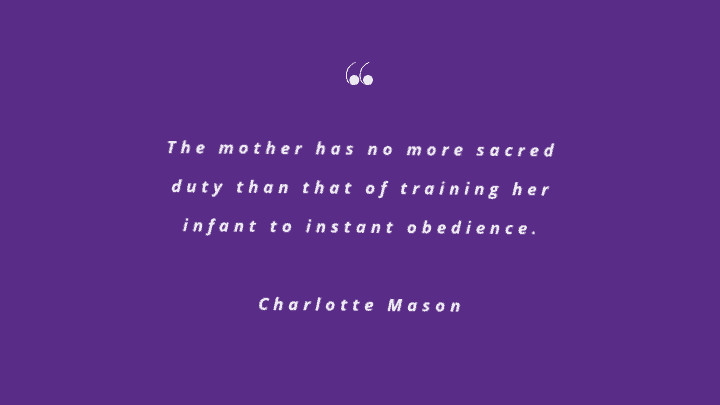
When my kids were very young, I was blessed with an older friend, Joy. Joy grew up as a missionary kid in Africa. One time over coffee and tea, she told me in her crisp British accent that when she was about three her mum suddenly told her to climb out of her high chair and crawl across the breakfast table to her. So, Joy immediately did what she was told. And it’s a good thing she did. Her mom saw something she couldn’t see — a poisonous snake heading for her chair.
Was that a normal request from her mother, to get out of her chair and crawl across the breakfast table? No. Despite that —Joy’s instant obedience could have saved her life.
Hopefully, your experiences in teaching obedience won’t be put to the test quite so dramatically!
So, what is the Charlotte Mason habit of Obedience, exactly?
The definition we use for obedience is this: your child does what you ask right after you ask it, with a pleasant attitude.
Allowing for the child’s age and ability, of course. Let me clarify: You would not expect an 11-month-old to be able to do what a 3-year-old or a 7-year-old could do, but you are moving toward that ideal of full obedience, beginning at an early age.
It takes our youngest children time to process the instruction, so it’s only logical to give them a few minutes to do so.
Remember as you’re practicing obedience to give your young child one instruction at a time. And because of your little one’s young age, he may not yet be able to do exactly what you want, yet. And yes, this takes some coaching — especially the part about having a good attitude.
Your part is to be calm, patient, and encouraging. And to follow through. Every time. Natural consequences are always the best. For example:
- “Because you didn’t come to me to put your shoes on as I asked you to, we aren’t going to be able to go to the playground.”
- “I see you are not picking up your toys as I asked. Since you have chosen not to help, the toys I pick up will be going into toy jail.” (i.e., out of circulation for a few days or so or until the child chooses to help pick up toys)
- “Since you played around instead of getting your chores done before we started school, you’re going to be staying inside and getting them done before you can go outside and play.”
I’m an advocate for starting early. After some instruction and a few repeats, my 8-month-old (at the time) grandson learned to touch Christmas tree ornaments with one finger, instead of grabbing them whole-handed.
And any experienced mama knows that there’s a window when a toddler’s greatest joy is being able to help you do something. So take advantage of that!
Want to grab a downloadable copy of this post to read later?
Consistency is the key to teaching your child obedience.
Charlotte Mason encouraged us to be confident in our God-given authority over our children. Not in an extreme or violent way, but in a calm, consistent, loving one.
And just like we started with teaching preschoolers the habit of attention, when you start training obedience, remind them about God giving parents a special job (training kids) and kids a special job (obeying parents).
The cost of not being consistent in expecting obedience
I love this quote from Charlotte Mason (found in Volume 1 of her Home Education series) about what happens when we don’t consistently require obedience. Can’t you relate? I can!
“This is the sort of thing which is fatal: The children are in the drawing-room, and a caller is announced. ‘You must go upstairs now.’ ‘Oh, mother dear, do let us stay in the window corner; we will be as quiet as mice!’ The mother is rather proud of her children’s pretty manners, and they stay. They are not quiet, of course; but that is the least of the evils; they have succeeded in doing as they chose and not as they were bid, and they will not put their necks under the yoke again without a struggle. It is in little matters that the mother is worsted.
‘Bedtime, Willie!’ ‘Oh, mamma, just let me finish this’, and the mother yields, forgetting that the case in point is of no consequence; the thing that matters is that the child should be daily confirming a habit of obedience by the unbroken repetition of acts of obedience. It is astonishing how clever the child is in finding ways of evading the spirit while he observes the letter. ‘Mary, come in.’ ‘Yes, mother’; but her mother calls four times before Mary comes. ‘Put away your bricks,’ and the bricks are put away with slow, reluctant fingers. ‘You must always wash your hands when you hear the first bell.’ The child obeys that once and no more.
To avoid these displays of willfulness, the mother will insist from the first on obedience which is prompt, cheerful, and lasting––save for lapses of memory on the child’s part. Tardy, unwilling, occasional obedience is hardly worth the having; and it is greatly easier to give the child the habit of perfect obedience by never allowing him in anything else…”
Reprinted from Ambleside Online
I imagine we can all relate to letting things slide a bit and then finding out just how difficult it is to reign in our kids again!
It’s MUCH better to be as consistent as possible with few exceptions and not overly demanding.
That said — if you are going to ask your child to do something, you must follow through if she doesn’t!
Crucial Charlotte Mason Habit #3 is Truthfulness
Charlotte Mason was clear that truthfulness, just like attention and obedience, has to be trained in our kids.
She summarized the problems with untruthfulness under three different headings:
- carelessness in ascertaining the truth
- carelessness in stating the truth
- a deliberate intention to deceive
Children are prone to the first two, and Ms. Mason thought that these were definitely less serious than the third one.
When I think of all three of these, I would say that it’s not uncommon today even for adults to be guilty of at least the first two. And sadly, even in the third. In our world today it’s becoming more and more important for our children to learn to listen, sift through what they are hearing, reading, and watching, and discern truth from fiction. And that goes for adults, too!
How to Teach the habit of truthfulness to your children
We start by training our children to be good listeners and to be careful and precise speakers.
Realize that part of growing up is learning that your parents aren’t all-knowing. And unfortunately, your kids are going to learn this at a way-too-early age. Face it: your kids are not going to always tell the truth. The key to instilling the habit of truthfulness in our children is starting early in recognizing what is truth and what is manipulation and dealing with it.
This means to teach your kids to:
- Always be clear about what is truth and what is pretending.
- Tell exactly what happened without exaggeration.
- Be discerning, and let them know how important it is that we protect others’ reputations by not passing along negative information about other people. If something they heard or noticed about someone bothers them, have them talk to you or your spouse about it instead of their friends.
Ask clarifying questions when your children include words such as “Everybody says,” or “Everyone knows,” or “all the time.” Train your children to be specific in their speech. Just pointing this out will help your kids become more discerning about what they hear and start asking those questions of others when they hear those “all-inclusive” words.
Most importantly, part of bringing your kids’ education to life is speaking the truth in your home as parents and expecting truthfulness from your children. So although we probably think of Attention and Obedience first as the more important habits, Truthfulness is just as essential.
You can also read and discuss good books that highlight truthfulness:
This delightful book is about a young Chinese boy named Ping who loved flowers. He entered a contest put on by the Emperor of China, who also was a lover of flowers. But even with all his careful tending, Ping’s flowers would not grow. Read about Ping’s honesty and good character, and how it was rewarded in this inspiring story. (Interest Level: K to 2nd grade.) If you have our Primary Unit Program Tools for K-2nd grade, you’ll find this book listed in the Ancients Unit, under Ancient China.
This is a sweet book with a clear message about a young girl tempted to lie about wrecking her mom’s flowers. And just as important, it’s an excellent example of how a mother might handle the situation with grace and related consequences. Approaching an obvious lie calmly and acknowledging the feeling behind it (usually fear of consequences) goes a long way in teaching your child to tell the truth.
This book is free (at the time of this writing) on Kindle Unlimited but is not formatted properly for a Kindle, so I would buy it as a paperback.
This beautifully illustrated book is from the Good News from Little Hearts series and edited by Edward T. Welch. It’s listed as suitable from 4-7. Gwen Raccoon begins telling lies to do what she wants and gets in deeper and deeper until she’s caught. This book offers grace-based help for telling the truth with an excellent special section called “Helping Your Child with Lying.” And it has a tear-out page in the back of the book with four “Back Pocket Bible Verses” dealing with telling the truth.
Tips for Teaching Truthfulness to Older Children
Particularly from middle school on up, remember that your actions are being watched and evaluated by your children. All.the.time. You may not realize it, but they are paying attention. They notice it when you say, “I’m sorry I’m late, but the traffic was horrible,” when you really should have left earlier to arrive on time.
We don’t want to be modeling that making excuses instead of taking responsibility for our actions is okay. As hard as this is sometimes, we must think about what kind of examples we are to our children in this area. I know, we all blow it, so give yourself grace. But remember, we may be teaching as much or more with our actions as we are with our mouths.
Also, it’s helpful for you to talk about it when you have a choice and choose to do the right thing instead of the expedient thing: “It’s such a beautiful day that I’m tempted to cancel that appointment and go to the park, but I made the appointment and they are counting on me to be there on time. So let’s plan to go to the park tomorrow.”
Teach your older children to evaluate what they read, hear, and watch on TV.
When your children reach middle and high school, start teaching them about “author’s bias. ” Your discussions should include not just books but also television (commercials, shows, and movies) and music.
What is Author’s Bias? It means that everyone who produces something — either a book, an article, a TV show, a movie, a commercial, or a song has a set of beliefs and values. That set of beliefs and values influences his or her work. An author may be biased against something, or in favor of something.
Although sometimes an author really works at being neutral and presenting both sides of something. (But I’m finding that less and less, aren’t you?)
So teach your older students to read or listen carefully to what the author’s beliefs and values might be. An easy way to introduce this is to watch a TV commercial. Find one on YouTube, like this one:
After you talk about what Author’s Bias is, watch and talk about this commercial.
Ask your kids:
- Does the author of this commercial say that exercise is good or bad?
- Why do you think that he says this?
- Who/what company created this commercial?
- Why do you think they created this commercial? Is there something they want the watcher to do?
(They are saying that exercise is good so you should be like this man and buy a pair of Nike’s to keep running in your 80s as he does. So the author’s purpose is to get you to buy Nike’s.
All commercials try to get you to buy their products. Understanding this helps your kids learn to think about the author’s bias and purpose instead of just accepting as fact everything they see and hear.)
Find other commercials to watch with your kids, and talk about how the commercial’s sponsor is trying to get them to buy things. And talk about HOW they are doing it.
When your older kids are familiar with the idea of Author’s Bias, have them answer these questions as they read:
- What do you think the author likes/doesn’t like?
- What quotes from the book/article (with page/paragraph numbers) back up your thoughts? (Hint: What kind of words does the author use to describe people, things, or ideas in the book, song, commercial, etc.? Words that are positive, or words that are negative?)
- What is the author trying to get you to think about what he’s saying?
- Do you agree with the author? Why or why not?
Are you going to be able to perfectly train your kids to do all of the Charlotte Mason Habits?
No. Not all of them, and not perfectly. It would be great if we could have a family where the kids obeyed immediately and cheerfully all the time, you were always calm and patient, and your house was always clean and neat. But real life is messy! You are not perfect; you are going to make mistakes, and so are they.
But thankfully, there’s grace for that. You can identify your kids’ character weaknesses and work at training them to do better. (Just like we are always working on ourselves to do better.) And in the areas where they forget, you’ll work on it some more.
But don’t expect perfection, either from yourself or from them. That’s way too much pressure and only leads to discouragement.
We pray for our kids, work with them, train and correct them, and pray for them some more. We do our best, consistently train Charlotte Mason habits, and trust God with the rest.
Even though your family will never be perfect, I guarantee if you consistently train your children and practice the three Charlotte Mason habits of Attention, Obedience, and Truthfulness, you’ll be well on your way to bringing your kids’ education to life while still balancing your other responsibilities.
Happy Training!
![]()
Want to grab a downloadable copy of this post to read later?
